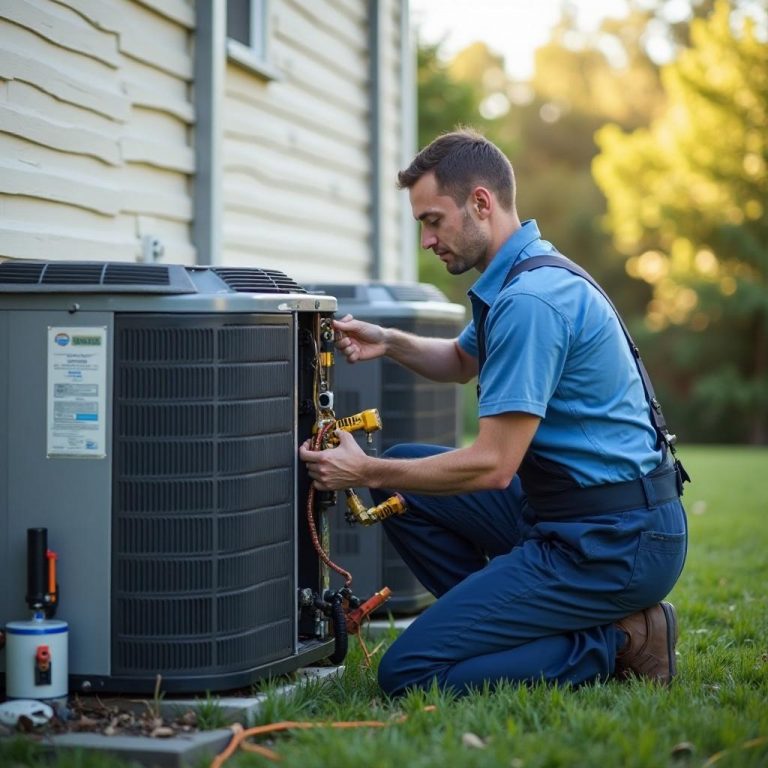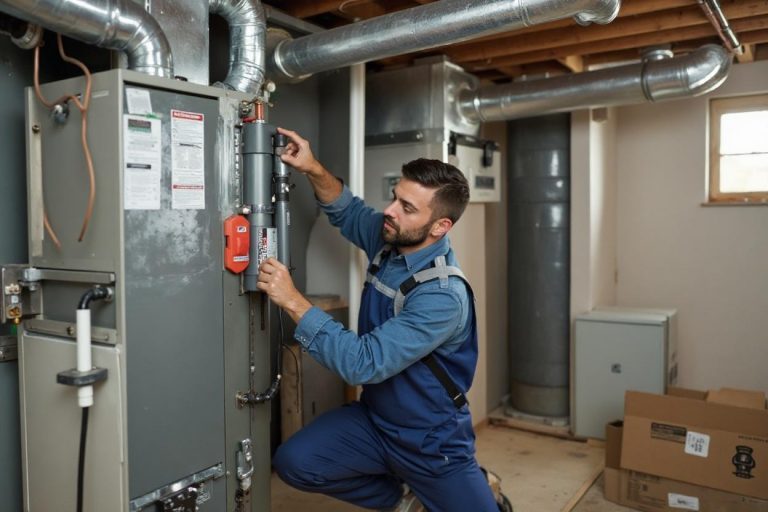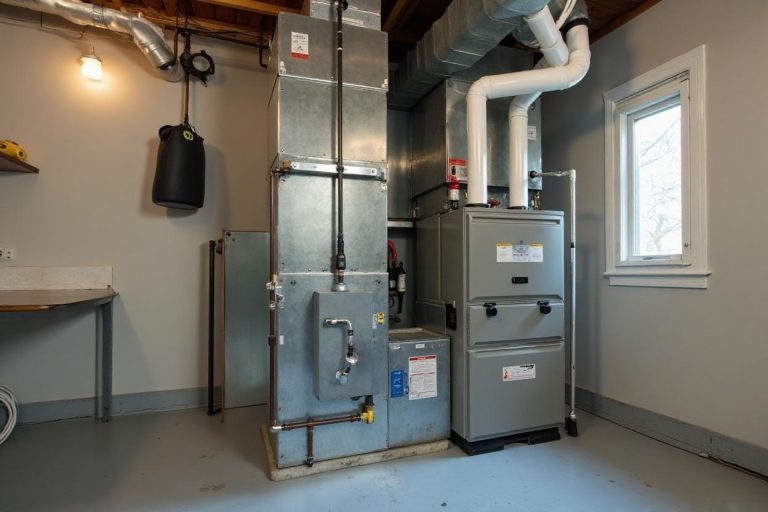2025 Furnace Installation Cost in Middlefield, CT
Replacing a furnace is one of those projects you feel in your bones — and in your monthly bills. In Middlefield, CT, where winter snaps down fast and sticks around, a reliable, efficient heating system is not a luxury. It’s your daily comfort and your biggest energy spend from November through March. If you’re weighing a new furnace installation in 2025, this guide lays out real numbers, the local factors that move the price up or down, and smart ways to protect your budget without cutting corners.
Direct Home Services installs and services gas and oil furnaces across Middlefield and nearby neighborhoods. We know the quirks of older capes on Strickland Road, tight basements off Main Street, and newer construction near Lake Beseck. The goal here is straightforward: give you a clear cost framework, explain the choices that matter, and help you decide when to repair and when to replace.
The short answer: typical furnace installation costs in Middlefield, CT
Most homeowners in Middlefield pay between $5,800 and $11,500 for a complete new furnace installation, including equipment, standard accessories, and professional installation. The largest share of projects lands in the $7,500 to $9,800 range.
Where you may land in that range depends on five big drivers: fuel type (natural gas vs oil), equipment efficiency (standard vs high-efficiency condensing), home size and ductwork condition, venting and flue requirements, and permitting or code updates. Add-on options like humidifiers, smart thermostats, and air quality upgrades can push the price higher, but they also solve real comfort issues common in Connecticut winters.
If your home needs extensive duct replacement, oil-to-gas conversion, or chimney liner work, plan for a wider range of $9,500 to $16,000. We’ll break down why those items move the needle.
What you’re paying for: equipment, labor, and the hidden work that matters
A furnace installation is not just a box swap. A safe, efficient, code-compliant job in Middlefield includes accurate sizing, careful venting, gas or oil piping adjustments, condensate management for high-efficiency units, startup calibration, and paperwork for your town permit. Here’s how the budget usually divides across a typical job:
- Equipment: 55 to 70 percent. The furnace itself, plus add-ons like an ECM blower motor, two-stage or modulating burner, media filter cabinet, and smart thermostat.
- Labor and project time: 25 to 40 percent. Includes removal of the old unit, new unit set, gas or oil line work, venting, drain, electrical, safety tests, and commissioning.
- Code items and materials: 5 to 15 percent. Vent pipes, chimney liner if needed, sheet metal transitions, isolation pads, drip legs, shutoffs, permit fees, and haul-away.
The cleanest installs happen when the furnace is sized correctly, ductwork is airtight, static pressure is reasonable, and combustion numbers are dialed in. That last part—combustion analysis and commissioning—costs very little time on site but pays dividends in efficiency, noise level, and reliability.
Gas vs oil: what Middlefield homeowners actually choose
Middlefield has a mix of natural gas and oil. If you already have natural gas service to the house and a gas meter, a gas furnace is almost always the most cost-effective long term. If you run oil, that’s common too, and modern oil furnaces can be highly efficient with proper setup.

Gas furnace install ranges: $5,800 to $10,500 for most homes. High-efficiency gas (95 to 98 percent AFUE) generally lands between $7,800 and $11,000 depending on staging and venting conditions. Standard efficiency gas (80 percent AFUE) is less common in our area because most towns and utilities encourage high-efficiency for energy savings, and many homes do not have a suitable chimney for an 80 percent vent without liner work.
Oil furnace install ranges: $6,800 to $12,500 for most homes. Oil systems carry slightly higher equipment and burner costs, and oil lines, filters, and venting tweaks add labor. If your steel oil tank is older than 30 years, plan for a tank inspection. Tank replacement is a separate scope, but it’s a common conversation during new furnace installation.
Conversion from oil to gas: If you plan to convert, add the gas utility’s service timeline to your planning. The gas line from street to meter is usually handled by the utility with its own schedule. On the home side, we size and install the interior gas piping, and cap or remove the oil tank. Budget for the following: gas piping inside the home, chimney liner if needed for other appliances, possible electrical upgrades, and the tank handling. These variables can add $2,000 to $6,000 depending on scope.
How efficiency affects your price and your bill
AFUE is the efficiency rating that matters in Connecticut winters. A jump from an 80 percent furnace to a 96 percent model means much less fuel wasted. On a typical Middlefield home with $1,400 to $2,000 in yearly heating fuel spend, moving to high-efficiency gas can save $200 to $400 per season. Over 10 to 12 years, that difference often covers the higher upfront cost.

Two-stage and modulating gas valves smooth the heat output, reduce temperature swings, and run quieter. We usually see tighter homes in newer Middlefield developments benefit most because longer low-stage run times keep rooms even. Older homes with varied insulation also feel more comfortable, but they may need duct sealing or insulation upgrades to get full value.
For oil furnaces, high-static blowers and clean, well-tuned burners matter more than the labeled AFUE. Annual service, nozzle sizing, and combustion tuning are critical to keep oil systems running near their rated efficiency.
The ductwork question: keep, modify, or replace
Many Connecticut homes have duct systems that date back decades. They still move air, but leaks, undersized returns, and poor transitions can choke a new furnace. We measure static pressure, examine trunk sizes, and look for leakage at seams and takeoffs.
Small fixes like sealing and adding a return can support a new furnace at low cost. Larger changes like resizing trunks or replacing a failing plenum can add $800 to $2,500, but they often reduce noise, improve airflow to the second floor, and prevent blower strain. Full duct replacement or adding ducts to an unfinished space is a different scope and can add $4,000 to $9,000 depending on access and size.
Here’s a quick rule from the field: if your old furnace sounded like a hair dryer and your second-floor bedrooms ran cold, the duct system, not the furnace alone, caused the discomfort. A new furnace helps, but duct fixes solve the root cause.
Venting and chimney liners: the gotchas that change your quote
High-efficiency gas furnaces vent with PVC or polypropylene through a sidewall or roof. We aim for short, direct runs with proper pitch and clearances. Materials and labor for new venting typically add $400 to $1,200.
If you plan to keep an 80 percent gas furnace, it likely vents into a chimney. Most masonry chimneys need a stainless liner to keep exhaust temperatures safe and draft reliable. A chimney liner install often adds $900 to $1,800. If other appliances share the chimney, we plan the venting to avoid conflicts.
Oil furnaces usually continue to use the chimney with the correct liner. Draft and combustion numbers will guide whether we suggest a barometric damper adjustment or liner upgrade.
Sizing for Middlefield homes: BTUs that match your envelope
Sizing by square footage alone is guesswork. We use a load calculation that factors insulation levels, windows, infiltration, and orientation. A typical 1,800-square-foot Middlefield colonial often lands between 60,000 and 80,000 BTU input for gas if the home has decent insulation and windows. Older homes with original windows and limited insulation can need a size bump, but we still avoid oversizing because it causes short cycling, hot-and-cold rooms, and higher fuel use.

A quick anecdote: a cape near Lake Road had a 120,000 BTU furnace installed years ago “just to be safe.” The first floor roasted while the upstairs never caught up. We recalculated the load, installed an 80,000 BTU two-stage unit, added a return to the second floor, and balanced airflow. The house now holds steady within one degree, and the gas bills dropped by about 18 percent.
Permits, code, and inspections in Middlefield
Middlefield requires permits for new furnace installation. Expect inspections to cover gas or oil piping, venting, electrical, and clearances. We handle the permits and coordinate inspections. Timelines vary by season, but most projects wrap in a day for straightforward replacements and two days when venting or duct work expands the scope. If the install is part of a larger conversion, we plan around the gas utility schedule and the town’s availability.
Rebates and financing in 2025
Connecticut residents often qualify for utility rebates for high-efficiency gas furnaces. Programs change year to year, and funding opens and closes. In 2025, we are seeing rebates most often tied to furnaces at 95 percent AFUE or higher with an ECM blower. The amounts vary. Some homeowners also stack smart thermostat incentives. We help you submit the paperwork and include the rebate expectations in your written quote so you can see net costs clearly.
Financing can flatten the impact of a winter replacement. Many clients choose low-rate options to spread payments over 36 to 72 months. If your current furnace fails in January, a same-day temporary fix plus a next-day replacement plan is common, and financing makes the timing manageable.
What adds or subtracts from your total: Middlefield-specific factors
Home access and layout. Older basements with narrow stairways add labor time. If we need to disassemble an old furnace or build new transitions in tight quarters, the job runs longer. Houses with clean mechanical rooms near exterior walls are quicker and cheaper for venting.
Combustion air. Modern furnaces prefer sealed combustion that pulls air from outside for the burner. If your mechanical room is tight or shares space with a laundry, sealed combustion avoids pressure issues and backdraft risks.
Electrical. Most new furnaces need a dedicated circuit and correct grounding. If your panel is full or the run is long, an electrician may add minor costs. We plan this at the quote stage to avoid surprises.
Add-on comfort features. Middlefield winters dry out indoor air. Many homeowners add a whole-home humidifier with a new furnace. A smart thermostat helps set schedules and track filter changes. Media filter cabinets improve air quality and keep the blower clean. Each adds cost, but they solve real comfort problems.
The case for replacement vs repair
If your furnace is under 12 years old and needs a simple fix such as an ignitor, flame sensor, or limit switch, repair often makes sense. Once you cross 15 years, and repairs involve the heat exchanger, control board, draft inducer, or blower motor, the math shifts. Spending $1,000 to $2,000 on an aging 80 percent unit has less value than applying that cost to a high-efficiency replacement, especially with rebates.
We also look at your monthly bills, runtime patterns, and noise. If your gas or oil use has crept up year over year without a corresponding weather change, that is a sign of efficiency decline or duct leakage. A home on Main Street replaced a 20-year-old 80 percent gas unit with a 96 percent two-stage. After a cold January and February, their usage data pointed to a 22 percent drop. They were home more that winter, so the real savings may be even higher when adjusted for occupancy.
What a smooth new furnace installation looks like
We start with a site visit. We confirm load, inspect ductwork and vent options, check gas or oil lines, and measure static pressure. We listen to your comfort complaints. Cold bedrooms. Hot first floor. Noise in the hallway. Dry air and static. These details guide equipment choices.
We present a clear proposal with two or three options: base high-efficiency, a comfort-focused step with two-stage or modulating heat, and a value build if your ducts or home don’t benefit from staging. We spell out what is included: permits, venting materials, filter cabinet, thermostat, haul-away, and commissioning.
On installation day, we protect floors, remove the old unit, modify or replace transitions, set and level the new furnace, connect gas or oil lines with drip leg and shutoff, run vent pipes with correct slope and clearances, and route condensate to a drain with an overflow safety where needed. We perform combustion testing, adjust gas pressure, verify temperature rise, and confirm the thermostat logic matches the staged equipment. We label everything and review maintenance schedules with you.
You get a final walk-through. We explain filter changes, thermostat settings, humidifier care, and warning signs to watch for. You receive permit records, warranty terms, and any rebate documents ready to submit.
Common homeowner questions we hear in Middlefield
Will a high-efficiency gas furnace be louder than my old one? Typically, no. Two-stage and ECM blowers run quieter at low speed. If you hear whooshing or whistling, that’s usually duct restriction. We can fix that.
How long does a furnace last here? Gas furnaces usually last 15 to 20 years if maintained. Oil furnaces can hit similar ranges with annual tune-ups and clean fuel lines. The heat exchanger is the limiting factor. When it cracks or rusts, replacement is the safe choice.
Can I keep my existing thermostat? If it supports your new staging and blower logic, yes. Many older thermostats only switch heat on and off. You gain comfort and savings with a modern smart thermostat that can handle multi-stage control.
Do I need a chimney liner? If you keep an 80 percent furnace or have a water heater venting into the chimney, likely yes. We inspect and tell you directly. For 95 percent and higher furnaces that sidewall vent, a liner may still be required for remaining chimney-vented appliances.
What maintenance should I plan for? One annual visit. We clean burners, check flame signal, inspect heat exchanger, verify gas pressure, test safety controls, and measure combustion. We also check the condensate trap on high-efficiency units, which can clog over time if neglected.
A realistic cost scenario for a Middlefield colonial
An example from late winter last season: a 2,100-square-foot colonial near Baileyville Road with an aging 80 percent gas furnace, loud blower, and uneven heat. We Go to this website installed a 96 percent AFUE, two-stage 80,000 BTU furnace with ECM motor, a new media filter cabinet, PVC sidewall venting, a smart thermostat, and added a second-floor return. We sealed accessible duct joints. The total project was $9,450 before a utility rebate. After a $650 rebate and a thermostat incentive, their net cost was $8,650. Gas usage the next winter fell by about 18 percent despite similar degree days.
Another case: a ranch near Lake Beseck with an oil furnace from the early 2000s. The owner wanted to stay with oil. We installed a new high-efficiency oil furnace, replaced the barometric damper, cleaned and tested the chimney liner, upgraded the oil filter and lines, and tuned the burner. The job price was $8,900. The quieter blower and steadier temperatures were immediate. Annual service remains important to hold those gains.
How to prepare your home and your budget
- Clear a four-foot path to the furnace and the electrical panel. Tight spaces slow crews.
- Know your filter size, thermostat model, and any hot or cold spots you want solved. The more detail, the better the result.
- Decide whether indoor air quality matters for your family. If someone has allergies or frequent dry skin in winter, add that to the plan now rather than later.
These small steps help us quote accurately and deliver a smooth installation day.
Why homeowners choose Direct Home Services in Middlefield
We live and work in the same climate you do. We’ve carried furnaces down narrow basement stairs on Lake Avenue and we’ve re-piped oil lines in granite basements that fight back. Our team sizes systems based on actual loads. We explain the choices clearly. We don’t oversize to hide duct problems, and we don’t skip commissioning.
You’ll see the difference in steady room temperatures, a quieter blower, clean venting, and lower fuel use. You’ll also see it in how we follow through with permits and post-install support. If something does not feel right in the first week, we come back to fine-tune.
Ready to price your new furnace installation in Middlefield, CT?
If your furnace is limping into another winter or your energy bills have crept up, it’s time to run the numbers. We can visit, measure, and give you a clear written proposal with options. You’ll see exact equipment, scope, timeline, and any rebate estimates. No vague promises, no guesswork.
Call Direct Home Services or request a visit online. Ask for a load calculation and a venting plan with your quote. If you’re comparing bids, we’ll help you line up details so you can make a clean, apples-to-apples decision. A well-planned new furnace installation will keep your Middlefield home warm, quiet, and efficient for years, and it should start with straight answers on cost.
Direct Home Services provides HVAC installation, replacement, and repair in Middlefield, CT. Our team serves homeowners across Hartford, Tolland, New Haven, and Middlesex counties with reliable heating and cooling solutions. We install and service energy-efficient systems to improve comfort and manage utility costs. We handle furnace repair, air conditioning installation, heat pump service, and seasonal maintenance. If you need local HVAC service you can depend on in Middlefield or surrounding areas, we are ready to help.